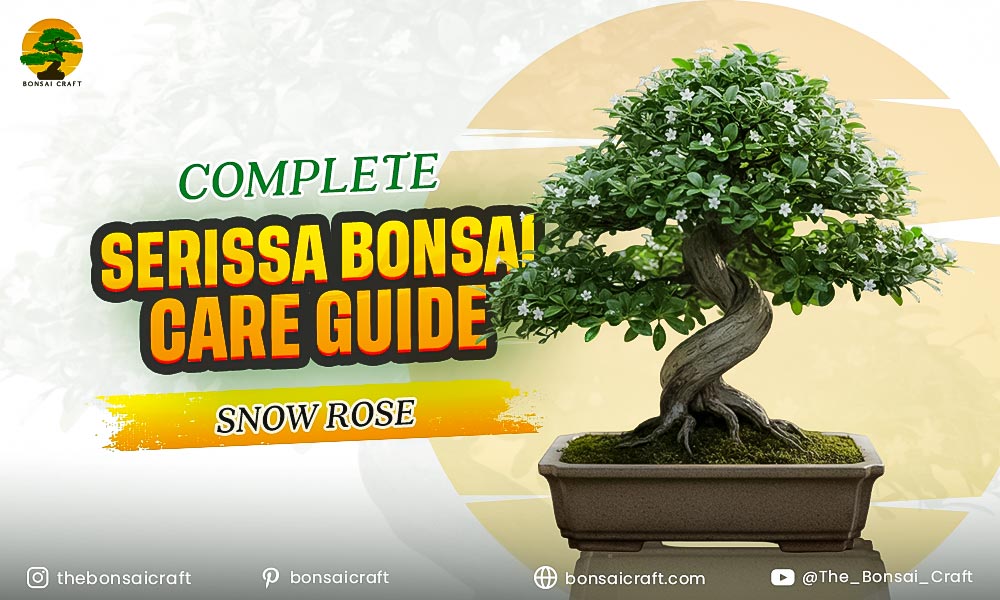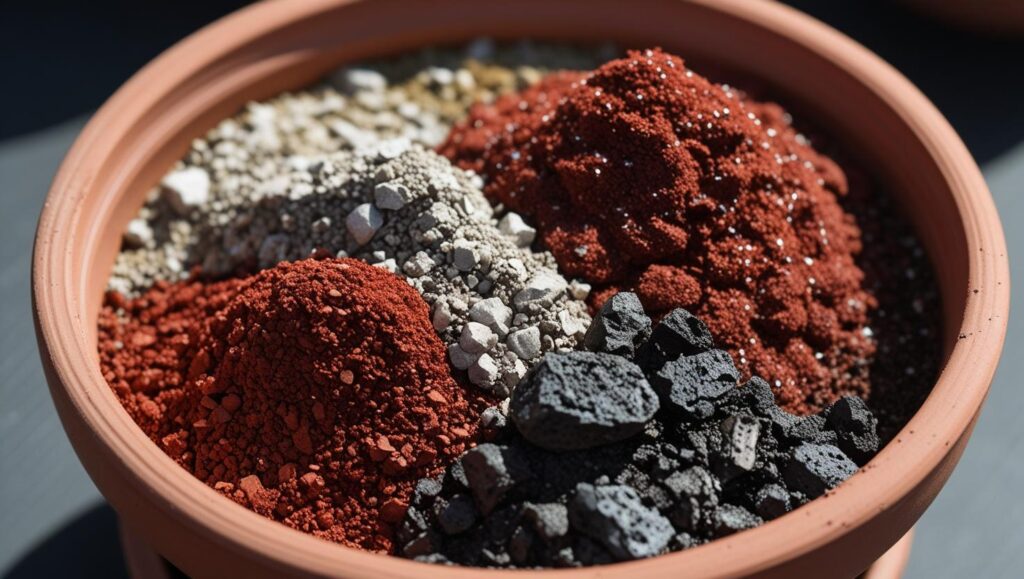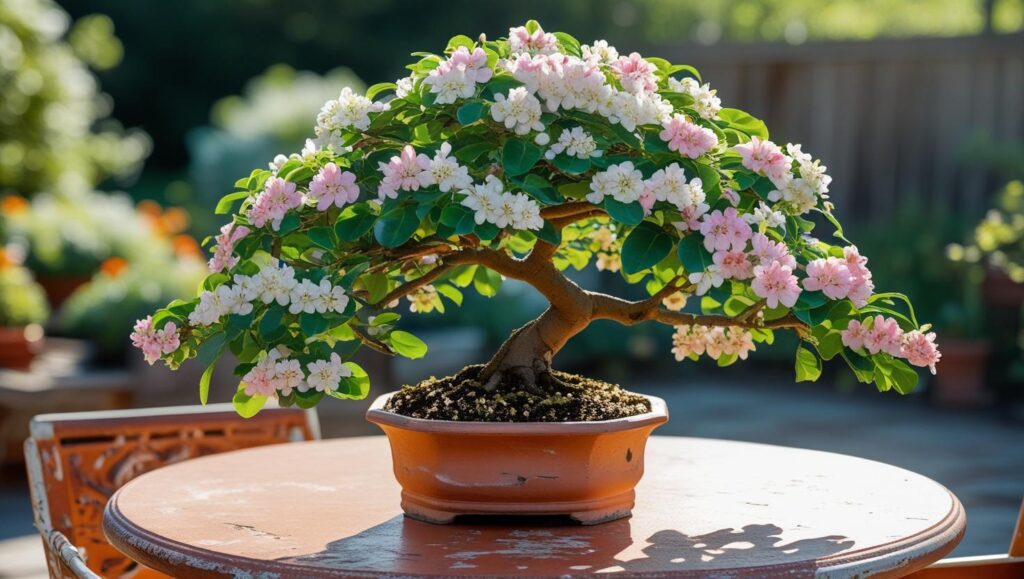
The Serissa Bonsai (commonly known as the Snow Rose Bonsai) is one of the most beloved bonsai varieties due to its stunning flowers and compact size. Whether you’re a seasoned bonsai enthusiast or a beginner, the Serissa is an excellent choice for those who want a flowering bonsai that thrives both indoors and outdoors. Known for its delicate, white, pink, or purple flowers, the Snow Rose Bonsai can add beauty and elegance to any space with proper care. In this guide, we’ll walk you through everything you need to know to grow, prune, and care for your Serissa Bonsai to ensure it thrives for years to come.
What is a Serissa Bonsai?
The Serissa Bonsai, also known as Snow Rose Bonsai, is a small flowering tree with delicate white, pink, or purple flowers. It’s perfect for indoor or outdoor spaces, offering beauty and elegance in a compact size. A Serissa Bonsai, or Snow Rose Bonsai, is a charming little tree known for its stunning flowers. The blooms come in shades of white, pink, or purple, making it a real eye-catcher. Its small size makes it a great option for those looking for a bonsai tree that fits easily into apartments or small gardens.
Not only is it a beautiful addition to your space, but it’s also a relatively easy-care bonsai, ideal for beginners and experienced growers alike. The serissa plant can be grown indoors or outdoors, depending on your environment. With the right care—proper light, watering, and occasional pruning—it will bloom multiple times a year, bringing beauty and elegance to your home.
What Are the Light Requirements for Serissa Bonsai?
Serissa Bonsai loves bright, indirect light. Indoors, it needs 4-6 hours of light per day; outdoors, filtered or morning sunlight works best. For your Snow Rose Bonsai to grow well, it needs plenty of light, but not direct sun that could burn its leaves. If you’re keeping it indoors, place it near a window where it can get around 4-6 hours of light daily. Serissa plant thrives best with bright, indirect light, so try to avoid placing it in full sun for long periods.
Outdoors, the Serissa Bonsai does well in morning sunlight or filtered sunlight during the day. Afternoon sun can be too harsh and may damage the leaves. If the tree isn’t getting enough light, it may not bloom as well, so be sure to check its placement regularly. Remember, while Snow Rose Bonsai needs light to grow, it also needs some protection from extreme heat, which could lead to burnt leaves.
How Should You Water Serissa Bonsai?
Serissa Bonsai should be watered when the soil is dry to the touch. Ensure it’s moist but not soggy, and avoid overwatering or underwatering. Water your Serissa Bonsai when the soil feels dry to the touch. It likes moist, well-draining soil but does not tolerate being waterlogged. Serissa Bonsai watering should be done carefully to avoid root rot.
Ensure that the pot has drainage holes for excess water to escape. During the growing season, water more frequently, but in winter, reduce watering as the tree is in its dormant phase. Be cautious of overwatering or underwatering, as either can harm the tree.
What is the Best Soil for Serissa Bonsai?
Serissa plant needs well-draining soil, ideally a mix of akadama, pumice, and lava rock, to prevent root rot and promote healthy growth. The Serissa Bonsai thrives in well-draining soil. A mix of akadama, pumice, and lava rock works best for promoting good drainage and preventing root rot.
Serissa Bonsai soil should retain some moisture while allowing excess water to escape. This mix ensures the roots stay healthy and well-aerated. Always ensure your pot has drainage holes to further prevent water buildup at the bottom. Repotting every 1-2 years will also help refresh the soil and maintain healthy root growth.
How to Fertilize Serissa Bonsai (Snow Rose Bonsai)?
Fertilize Serissa Bonsai once a month with a balanced fertilizer during the growing season. Reduce fertilization in winter when the tree is dormant. Serissa Bonsai fertilizing is important for healthy growth and flowering. During the growing season (spring to early fall), use a balanced water-soluble fertilizer once a month.
Fertilizing helps your Serissa Bonsai stay strong, healthy, and vibrant. In winter, when the tree goes dormant, stop fertilizing as it doesn’t need additional nutrients. Using an organic fertilizer like fish emulsion or compost tea is also a good choice, as it releases nutrients slowly and improves the soil’s health.
How to Prune Serissa Bonsai?
To prune Serissa Bonsai, remove dead or damaged branches, trim long stems to encourage branching, and remove wilted flowers to redirect energy into new growth. Pruning your Serissa Bonsai is key to maintaining its shape and health. Regular pruning helps keep the tree compact and encourages new growth. To start, remove dead or damaged branches to improve airflow and prevent disease.
Trim long stems to maintain a compact appearance and promote the growth of new branches. Prune just above the leaf nodes to stimulate fresh growth. After the tree blooms, remove spent flowers to allow energy to be directed toward new buds. Always prune after the flowering season to avoid cutting off potential new flowers.
How to Shape Serissa Bonsai?
Shape your SnowBonsai using copper or aluminum wire. Gently bend the branches and remove the wire once the tree’s shape has set. Serissa Bonsai shaping involves using copper or aluminum wire to carefully bend the branches into the desired form. Start by wrapping the wire around the trunk and branches, making sure not to damage the bark.
Gently bend the branches into place, following the tree’s natural growth. Copper wire is more durable and holds its shape longer, while aluminum wire is easier to manipulate. Once the tree has settled into its new shape, remove the wire to avoid scarring. Shaping should be done gradually, allowing the tree to adjust over time.
When Does Serissa Bonsai Bloom?
Serissa Bonsai blooms in spring and late summer, producing clusters of small white, pink, or purple flowers that create a snow-like effect. The Serissa Bonsai typically blooms in spring and late summer, showcasing small clusters of white, pink, or purple flowers. These flowers give the tree its signature snow-like appearance, making it a favorite among bonsai lovers.
To encourage Serissa Bonsai blooming, ensure the tree receives adequate light and water during the growing season. Regular pruning also helps promote new blooms. If the tree doesn’t bloom, check its light exposure, watering schedule, and nutrient levels. A healthy Serissa Bonsai will reward you with multiple flowering cycles throughout the year.
What Care Does Serissa Bonsai Need in Spring & Summer?
In spring and summer, provide Serissa Bonsai with adequate light, regular watering, and monthly fertilizing. Prune to maintain shape and encourage healthy growth.
During the spring and summer, the Snow Rose is in its active growth phase, so it needs a bit more attention. Here’s how you can keep it thriving during these seasons:
- Light: Ensure your Serissa Bonsai gets 4-6 hours of bright, indirect sunlight. This helps stimulate healthy growth and flowering.
- Watering: Water when the soil feels dry to the touch. The tree may need water more often in warmer weather, but avoid overwatering.
- Fertilizing: Fertilize once a month with a balanced, water-soluble fertilizer. This provides the nutrients needed for growth and blooms.
- Pruning: Trim back leggy growth to maintain a compact shape and promote new branching. After flowering, remove spent blooms to focus energy on new growth.
During these months, you’ll want to make sure your Snow Rose Bonsai is getting plenty of care to help it thrive. Regular watering and pruning will ensure it stays healthy and ready to bloom again. A well-maintained tree during spring and summer will reward you with vibrant flowers and strong growth.
What Care Does Serissa Bonsai Need in Fall & Winter?
In fall and winter, reduce watering and stop fertilizing. Place your Serissa Bonsai in a sunny spot and ensure it stays warm and well-lit indoors.
As the seasons change, the care for your Serissa Bonsai needs to shift. During fall and winter, the tree enters a more dormant phase. Here’s what to keep in mind for these cooler months:
- Watering: Water less frequently. The tree’s growth slows down, so the soil doesn’t need as much moisture. Let the top layer dry out before watering again.
- Fertilizing: Stop fertilizing. Serissa Bonsai doesn’t require additional nutrients during dormancy, and too much fertilizer could stress the plant.
- Light: Even in winter, your Snow Rose Bonsai still needs light. Place it in a sunny spot where it gets indirect light. If growing indoors, ensure it’s near a window that gets enough light.
- Temperature: Keep the tree in a stable environment, ideally between 60°F (15°C) and 75°F (24°C). Avoid placing it in areas with extreme temperature fluctuations, such as near heaters or drafts.
Though the serissa plant may not be actively growing during the fall and winter, providing consistent care will help the tree stay healthy and ready to flourish again when spring arrives. Be mindful of its reduced needs during these seasons and adjust your care routine accordingly.
Why Does Serissa Bonsai Drop Leaves?
Snow Rose Bonsai may drop leaves in winter as part of its natural dormancy. If it drops leaves at other times, check for pests or improper care. Leaf drop is a natural process for the Serissa Bonsai, particularly during winter when the tree enters dormancy. During this period, the tree sheds its leaves to conserve energy.
However, if it drops leaves at other times, it could indicate issues such as pests, like aphids or spider mites. It may also be a sign of stress from improper care, such as overwatering or underwatering. Ensure your tree has the right watering schedule, isn’t exposed to extreme temperatures, and is free from pests. Regular care and attention can help prevent unexpected leaf drop and keep your tree healthy.
How to Manage Pests on Serissa Bonsai?
Serissa Bonsai is susceptible to pests like aphids, spider mites, and mealybugs. Treat infestations with neem oil or insecticidal soap to protect the tree.
Like many bonsai trees, Snow Rose Bonsai can attract pests that can damage the plant if not controlled. Here’s how to manage pests and keep your tree healthy:
- Pests to Watch For: The most common pests for Snow Rose Bonsai include aphids, mealybugs, spider mites, and scale insects. These pests can suck the sap from the tree, leading to yellowing leaves, weakened growth, and even the death of branches if left untreated.
- Inspect Regularly: Regularly check your tree, especially the undersides of the leaves and between the branches, for any signs of pests. You may notice small spots, webbing, or a sticky substance on the leaves, which are signs of pest activity.
- Treatment: If you spot pests, treat your Serissa Bonsai with neem oil or an insecticidal soap. These are natural and effective treatments that won’t harm your plant. Simply spray the affected areas, making sure to cover all leaves and stems.
- Preventive Measures: To prevent future infestations, ensure your tree is healthy and free from stress. Pests tend to target weak or stressed plants, so keeping your Serissa Bonsai well-watered, properly fertilized, and in the right lighting conditions will help it resist pests.
Treating pests as soon as you notice them and providing a consistent care routine will help keep your Snow Rose Bonsai looking its best year-round.
How to Prevent Root Rot in Serissa Bonsai?
Prevent root rot by ensuring your Serissa Bonsai is planted in well-draining soil and by avoiding overwatering, which can cause the roots to suffocate. To prevent root rot in Serissa Bonsai, use well-draining soil that allows water to flow through easily. A mix of akadama, pumice, and lava rock is ideal for maintaining proper drainage. Make sure the pot has enough drainage holes at the bottom to allow excess water to escape.
Always check the soil moisture before watering; only water when the soil feels dry. Overwatering can cause the roots to suffocate and rot, so it’s important to avoid letting water sit at the bottom of the pot. By providing the right soil and proper watering, you can keep your Serissa Bonsai healthy and prevent root rot.
How to Revive a Sick Serissa Bonsai?
To revive a sick Snow Rose Bonsai, adjust watering habits, check for pests, repot in fresh soil, and provide optimal light and temperature conditions. If your Serissa Bonsai looks unhealthy, start by adjusting its watering habits. Overwatering or underwatering can cause stress, so check the soil moisture regularly. If the roots look unhealthy or smell bad, repot the tree in fresh, well-draining soil, trimming away any rotten roots.
Inspect the plant for pests, as they can weaken the tree. If pests are present, treat the tree with neem oil or insecticidal soap. Place the tree in a well-lit area with stable temperatures (ideally 60°F to 75°F). By adjusting care and addressing any pest issues, your Snow Rose Bonsai can recover and thrive again.
How to Keep Your Serissa Bonsai Healthy Long-Term?
To keep your Serissa Bonsai healthy long-term, ensure consistent care with proper watering, pruning, fertilizing, and maintaining optimal light and temperature. For long-term care of your Serissa Bonsai, consistency is key. Ensure the tree receives enough indirect light for 4-6 hours a day. Water it when the soil feels dry but not soaked, and use well-draining soil to prevent root rot.
Pruning regularly helps maintain its shape and encourages fresh growth. Fertilize once a month during the growing season with a balanced fertilizer. Serissa Bonsai also thrives in stable temperatures, ideally between 60°F (15°C) and 75°F (24°C). Avoid placing it near drafts or heat sources. Regularly check for pests and ensure the tree’s environment remains consistent to keep it healthy for years.
Conclusion
The Serissa Bonsai, or Snow Rose, is a rewarding tree to care for. With consistent attention to watering, pruning, and light, it will thrive and bloom beautifully. The Serissa Bonsai is a rewarding tree that brings elegance and beauty to your home or garden. With proper Serissa Bonsai care, including regular watering, pruning, and providing the right light conditions, your tree will thrive and bloom multiple times a year.
It’s important to give it consistent attention, especially when it comes to soil moisture, light, and temperature. Whether indoors or outdoors, the Bonsai can grow into a stunning centerpiece. By following the guidelines in this care guide, you’ll enjoy a healthy, vibrant tree that enhances your space for years to come.
Serissa Bonsai Care – FAQs
Can Serissa Bonsai Be Grown Indoors?
Yes, Serissa Bonsai can be grown indoors. It needs bright, indirect light and consistent watering. Place it near a sunny window to ensure proper light, and maintain a stable environment to help it thrive indoors.
How Often Should I Water My Serissa Bonsai?
Water your Serissa Bonsai when the soil feels dry. In spring and summer, water it regularly. In winter, reduce watering as the tree enters dormancy. Ensure the soil remains moist but not waterlogged.
Why Is My Serissa Bonsai Not Blooming?
If your Serissa Bonsai isn’t blooming, check for insufficient light, improper watering, or lack of nutrients. Ensure it receives enough indirect sunlight, maintain proper soil moisture, and fertilize during the growing season for optimal blooms.
How Do I Repot My Serissa Bonsai?
Repotting Serissa Bonsai is needed every 1-2 years. Choose a larger pot with drainage holes, remove the tree, trim the roots, and place it in fresh, well-draining soil. Water thoroughly after repotting to help it settle into the new soil.



